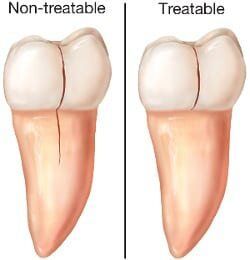Cracked teeth: Save or Extract?

2TheApex: There is no cut and dry answer for cracked teeth. The decision to extract or save a tooth should be based on a through clinical evaluation and a discussion with the patient about prognosis, risks, benefits, and alternative treatment options.
Cracked teeth (not to be confused with split teeth or vertical root fractures) are a challenging topic to discuss with patients. Below is a small checklist that we use to run through decision making with the patient when deciding to save or extract a tooth.
1) What does the patient want? Are they willing to take the risk of the tooth having a short life span even with root canal treatment and crown placement?
2) Systemic factors: history of bisphosphonate treatment, poor options for replacement, upcoming joint replacement surgery etc…
3)Probing depths. [Better prognosis] < 6 mm < [worse prognosis]. Deep narrow defects are a bad sign, however remember that not all teeth with fractures will present with detectable periodontal defects.
4) Radiographic findings. Is there a vertical defect or bone loss in the furcation?
5) Is the tooth vital or necrotic? There is some research to suggest that teeth that undergo necrosis from a fracture may have a poor prognosis.
6) How far apically does the crack extend internally? Good: crack stops coronal to CEJ. Questionable: Crack extends to CEJ or pulpal floor but not beyond. Poor: Crack extends into canal or onto pulpal floor. Hopeless: Crack extends entire length of tooth across pulpal floor and both margins.


